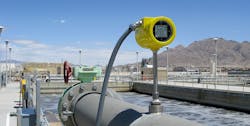One of the biggest expenses in wastewater treatment operations is the cost of energy to run the blowers and compressors that produce air for the aeration basins. The figures most often cited are that 40 to 50 percent of a wastewater plant’s total energy usage can be attributed to the aeration process.
By measuring the system’s air flows with accurate, repeatable thermal air/gas flow meters, the aeration process can be better controlled to optimize the process and minimize plant energy cost. Three flow sensor technologies typically have been used in aeration air flow monitoring applications in wastewater treatment plants: differential pressure (orifice plates), vortex shedding technologies, thermal dispersion (mass flow).
Each of these technologies has their advantages in various applications. Only one of them, however, is well suited to the hot, humid dirty conditions found in aeration systems, providing direct mass flow measurement for more dependable accuracy with virtually no maintenance. Learn how choosing thermal mass flow sensor technology in this application reduces installation costs, improves aeration efficiency and lowers the electric power cost of aeration systems.
Editor's Note: Scranton Gillette Communications and the SGC Water Group are not liable for the accuracy, efficacy and validity of the claims made in this piece. The views expressed in this content do not reflect the position of the editorial teams of Water & Wastes Digest, Water Quality Products and Storm Water Solutions.
